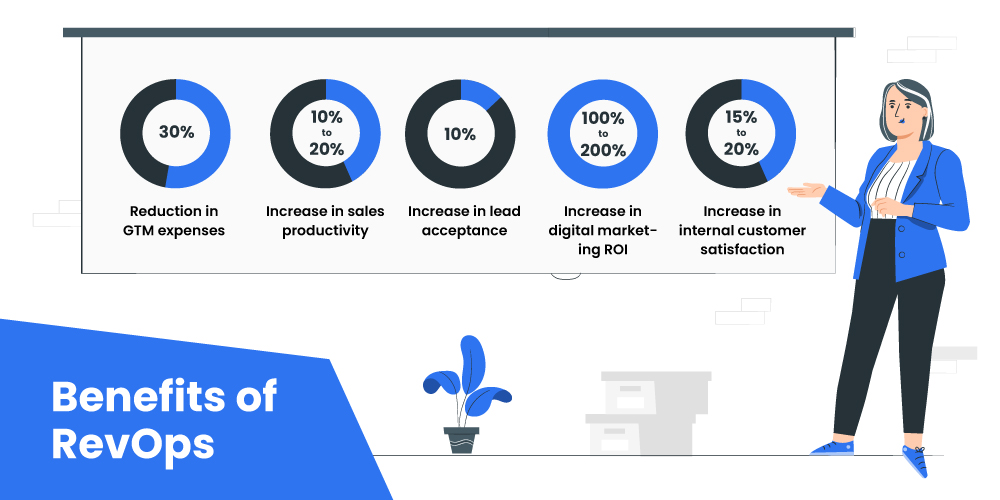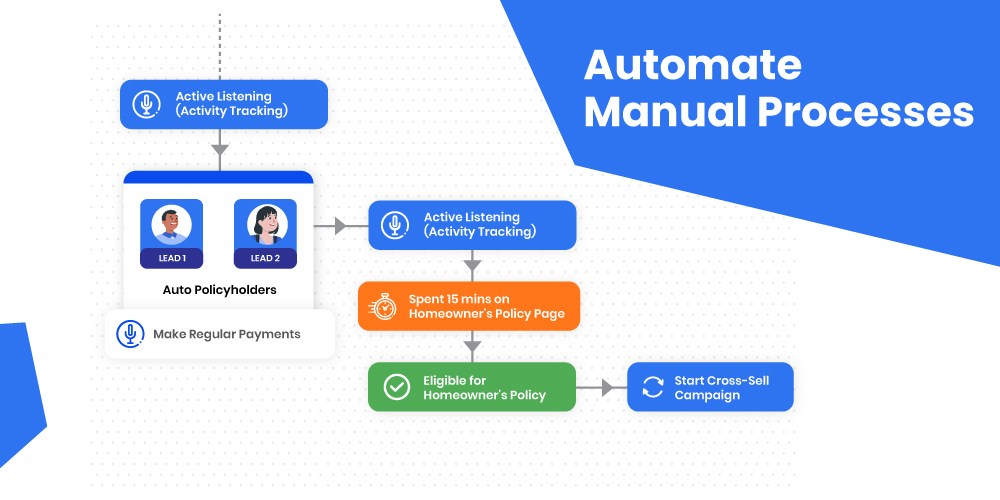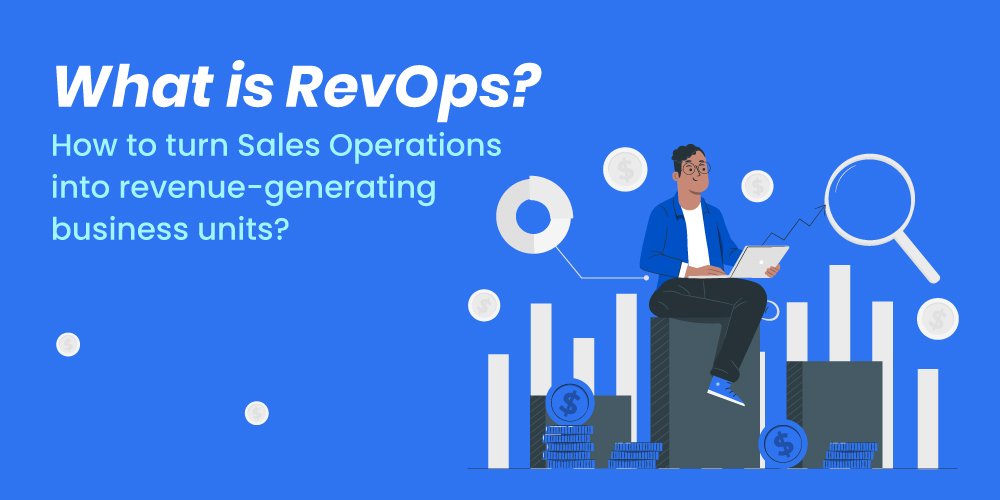By definition, Revenue Operations or RevOps refers to the strategic alignment of every department that contributes to revenue in an organization. What does this mean?
- It connects different departments within a single organization by breaking through departmental silos.
- It typically involves customer-facing departments and tracks customer-centric metrics for later analysis.
Today, many departments must communicate effectively and collaborate to improve the digital customer experience. Revenue Operations is the approach to bring them all together and, more precisely, analyze the return on investment (ROI) in those departments. With analytics and AI, RevOps teams can find trends and possibilities that drive revenue streams. According to Boston Consulting Group, top B2B IT businesses who used revenue operations to accelerate their growth saw substantial results, including increased sales productivity by about 10% to 20%.

Their research also showed that tighter alignment between teams resulted in:
- 100% to 200% increase in digital marketing ROI
- 10% increase in lead acceptance
- 15% to 20% increase in internal customer satisfaction
- 30% reduction in GTM expenses
With all the statistics, we can reach a fairly straightforward conclusion. RevOps exist to maximize revenue potential by connecting different departments as a way of achieving their revenue goals.
How do RevOps maximize revenue potential?
Imagine for a moment that revenue isn’t just a by-product of your excellent service or product. Instead, revenue results from your Marketing, Sales, and Service departments acting as one powerhouse. Now that we’ve got some clarity on what RevOps teams do, the next question is how does one turn sales operations into revenue-generating units?
According to Revenuegrid, “Revenue Operations is the response to the requirement of companies for a multi-faceted approach to sales.” In 2018, Director of Revenue Operations job titles exceeded Director of Sales Operations by 68% on LinkedIn. However, this doesn’t mean that you have to get rid of your sales operations. It would help if you have a separate RevOps team that oversees the work of all your departments and reduces miscommunication while remaining objective. Sales operations should continue under revenue operations, albeit on a more concentrated micro level.
So what does the RevOps team do to transform sales operations into revenue-generating units?
1. Measure every piece of the process

Measurement entails using reports, analytics, and dashboards to better understand your company’s current state and performance. The power of measurement originates from the insights it generates. When you measure customer behavior you gain the opportunity to understand purchasing intent. Once you understand their purchasing patterns, likes and dislikes you can target relevant products through personalized campaigns. In short, operationalizing data is at the heart of how revops empowers your business.
For example, you can identify lost revenues, forecast future trends, and plan workforce levels by tracking revenue growth. A consistent gain in revenue year after year gives your strategies credibility. However, a declining trend indicates that significant changes are required immediately. In addition, the revenue metric provides essential information about your products. For example, if a product with specific features generates a lot of revenue, you know you should push those features more aggressively. Similarly, you’d pull back on features of the same product if it contributes little to nothing in terms of revenue generation.
How does one drive maximum value through measurement?
First, to drive maximum value, you need to align people and processes to support the organization’s vision. Second, it has to be a shared outlook – where sales, marketing, and customer service teams measure the same KPIs, metrics, and reports and know how to calculate them. For instance, simply agreeing that churn rate is an important metric to track doesn’t help if each department measures it differently. This is where RevOps steps in to ensure interconnectivity between your departments.
Measuring every aspect of the sales operations helps in discovering your organization’s formula for sales success. Measuring and tracking customer behavior also helps identify cross-selling opportunities for the sales team. For example, if a customer has bought a course in art and design, once the course ends, you can send a notification with a different course that pairs well with it- such as art history. Your sales operations teams can be better enabled when revenue operations operatives overlook and measure their processes.
2. Create customer-centric processes

The more positive customer experience, the greater the chances of increased revenue. It may sound like an oversimplification, but it is that simple. According to Forbes, companies with a customer experience mindset drive 4-8% higher revenue than the rest of their industries.
Customer lifetime value (CLV) is an important metric of the RevOps team to measure customer success. CLV determines how valuable a client is to an organization throughout their connection. According to Qualtrics, it is less expensive to keep existing consumers than to discover and attract new ones. To put it another way, enhancing the value of a company’s current clients is a means to boost revenue and growth.
Every minute that sales teams spend attempting to fill process gaps with shoddy systems or hack solutions is a minute they lose on gaining market share. Most teams nowadays are having trouble with relatively simple operational duties. It can take days to de-duplicate, upload, and allocate leads to sales reps. Lead leakage becomes the bane of every agent’s existence. But a RevOps department ensures sales and marketing alignment and interconnectivity among your existing customer-facing teams. This reduces leakage by ensuring that leads are quickly distributed among agents, and customers get speedy responses.
The RevOps team helps with understanding your customers’ diverse experiences and measuring feedback at every possible touchpoint. When a company understands its decisive drivers of CLV, it can adjust or continue its processes to align with the RevOps framework. Likewise, your sales team will generate more revenue when customer experience is at the core of company processes.
3. Break down departmental divisions

As the conventional model of compartmentalized operations teams isn’t working anymore, companies are starting to adopt RevOps. As a result, public companies with revenue ops also saw 71% higher stock performance (Source: SeriousDecisions). In addition, the traditional style of separate sales, marketing, and customer service operations will soon become obsolete due to the transformation of the sales and marketing funnel. Not to mention, teams across the organization need to share the same tools and data sources. As a result, the conventional sales and marketing funnel, which comprises clean handoffs between Sales, Marketing, and Customer Service, has been replaced by a funnel where all client-facing teams have responsibilities.
One of the leading causes of revenue leaks is interdepartmental siloes that cause miscommunication. Centralization guarantees data-driven decisions across customer-facing departments. RevOps breaks down department silos by moving the focus away from specific departments to a collective mindset that looks at the revenue flow throughout the entire company. What’s more important is finding a tool that seamlessly unifies various departments. A customer relationship management tool provides the visibility needed to align all revenue-focused teams. It’s the foundation of a successful revenue operations strategy. Once you find the right tool, you can connect your sales operations department with the various customer-facing teams to improve sales velocity and increase revenue.
4. Automate Manual Processes

Sales automation boosts revenue as 61% of businesses leveraging automation reported exceeding revenue targets in 2020. This data gives us a glimpse into why automating manual processes is beneficial in terms of revenue generation. Automating manual processes is typically misunderstood to be a method of replacing employees or automating individual tasks. That is far from the truth, as automation in the RevOps context impacts every member within your organization. For example, if you implement a workflow that maps every aspect of the customer journey, it invariably implicates stakeholders up and down that workflow.
This is why it’s critical to make sure operations teams are at the forefront of automation deployment. RevOps teams manage the intersection of people, systems, and procedures that keep businesses running. As a result, they have a unique grasp of employing automation technologies to supplement people, processes, and systems successfully. For example, your sales teams can automate manual processes such as campaigns, receive automated reports, and have leads distributed automatically. Both points involving measurement and creating customer-centric operations can be done with ease using automation.
When you begin to understand your customer’s behavior and intent, it is easier to nurture and follow up in the right way without annoying them. Sales automation gives you that power. It tells you which lead to follow and when to follow—making automation invaluable to every sales rep. Implementing automation across the organization also assists different departments in customer acquisition and retention. Your sales team’s ability to generate larger revenue is inevitable with the help of sales automation.
The bottom line
At the end of the day, your RevOps experience depends on two things: finding the right tools and aligning organizational processes. When you manage to use these tools and break down departmental silos, you can rest assured that revenue generation will soon come. Your sales operations teams similarly benefit from the implementation of RevOps in your organization. One tool indispensable to your RevOps is a CRM, which offers a singular view of data for different departments. A company-wide CRM guarantees three things-
- Data sharing across departments
- Automated workflows and notifications
- Reports and analytics to measure and track customer intent, agent performance, sales forecasting, and more.
Every organization looking to implement a revenue operations team needs a CRM to do so smoothly. If you’re looking for one such CRM, try LeadSquared for free!










